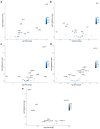Loss of Serpina1 in Mice Leads to Altered Gene Expression in Inflammatory and Metabolic Pathways
- PMID: 36142337
- PMCID: PMC9499171
- DOI: 10.3390/ijms231810425
Loss of Serpina1 in Mice Leads to Altered Gene Expression in Inflammatory and Metabolic Pathways
Abstract
The SERPINA1 gene encodes alpha1-antitrypsin (AAT), an acute phase glycoprotein and serine protease inhibitor that is mainly (80-90%) produced in the liver. Point mutations in the SERPINA1 gene can lead to the misfolding, intracellular accumulation, and deficiency of circulating AAT protein, increasing the risk of developing chronic liver diseases or chronic obstructive pulmonary disease. Currently, siRNA technology can knock down the SERPINA1 gene and limit defective AAT production. How this latter affects other liver genes is unknown. Livers were taken from age- and sex-matched C57BL/6 wild-type (WT) and Serpina1 knockout mice (KO) aged from 8 to 14 weeks, all lacking the five serpin A1a-e paralogues. Total RNA was isolated and RNA sequencing, and transcriptome analysis was performed. The knockout of the Serpina1 gene in mice changed inflammatory, lipid metabolism, and cholesterol metabolism-related gene expression in the liver. Independent single-cell sequencing data of WT mice verified the involvement of Serpina1 in cholesterol metabolism. Our results from mice livers suggested that designing therapeutic strategies for the knockout of the SERPINA1 gene in humans must account for potential perturbations of key metabolic pathways and consequent mitigation of side effects.
Keywords: RNA sequencing; SERPINA; alpha1-antitrypsin; data analysis; gene knockout; liver; metabolism; mice; protein misfolding; single-cell; transcriptomics.
Conflict of interest statement
The authors declare no conflict of interest.
Figures



References
-
- Sehgal A., Bumcrot D., Bettencourt B. Serpina1 Sirnas: Compositions of Matter and Methods of Treatment. 10935917B2. U.S. Patent. 2012 December 27;
MeSH terms
Substances
LinkOut - more resources
Full Text Sources
Medical
Molecular Biology Databases
Research Materials
Miscellaneous

